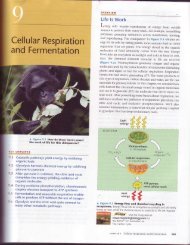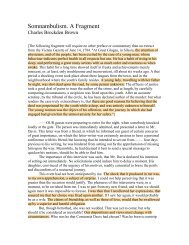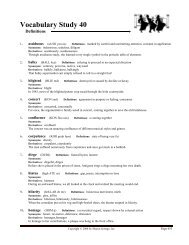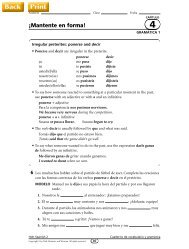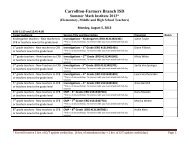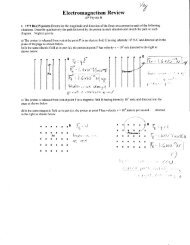Pt Two
Pt Two
Pt Two
Create successful ePaper yourself
Turn your PDF publications into a flip-book with our unique Google optimized e-Paper software.
UNIT NINE: Late Baroque and Rococo STUDY GUIDE<br />
P On Educating Children<br />
1. “Although he never married and he<br />
placed his own children in orphanages,<br />
the French-Swiss philosopher Jean-<br />
Jacques Rousseau formulated a<br />
behavioral program of childhood<br />
education that affected all French schools<br />
after the Revolution of 1789” (Stokstad,<br />
Art History 935).<br />
2. “Believing that children were inherently<br />
good until society corrupted them and<br />
broke their naturally independent,<br />
inquisitive spirits, Rousseau advised<br />
mothers to breast-feed their babies<br />
themselves, dress them in loose clothing<br />
with no bonnet, wash them in unheated<br />
water, give them freedom to crawl about,<br />
and never rock them, which Rousseau<br />
considered harmful. As boys grew, they<br />
were to be taught to value nature, human<br />
liberty, and personal valor and virtue.<br />
This environment would inevitably<br />
produce a citizen committed to political<br />
freedom and civic duty. Girls were to be<br />
educated only as needed for their futures<br />
as wives and mothers. Once married,<br />
women were to stay at home, out of the<br />
public eye, caring for their households<br />
and children, which Rousseau saw as „the<br />
manner of living that nature and reason<br />
prescribe for the sex‟” (935).<br />
R The French Salon<br />
1. “In the eighteenth century, the<br />
salon became the center of Parisian<br />
society and taste. The typical salon<br />
was the creation of a charming,<br />
financially comfortable, welleducated,<br />
and witty hostess (the<br />
salonniere) in her forties. She<br />
provided good food, a well-set table, and<br />
music for people of achievement in<br />
different fields who visited her hotel. The<br />
guests engaged in the arts of<br />
conversation, and in social and<br />
intellectual interchange” (Adams, Art<br />
Across Time 675).<br />
2. “In the seventeenth century, the most<br />
important salon had been that of<br />
Madame de Rambouillet, who wished to<br />
exert a „civilizing‟ influence on society. By<br />
the next century, the salon was a fact of<br />
Paris social life, and one in which women<br />
played the dominant role. Among the<br />
salonnieres were women of significant<br />
accomplishments in addition to<br />
hostessing. These included writers<br />
(Madames de LaFayette, de Sevigne, and<br />
de Stael, and Mademoiselle de Scudery), a<br />
scientist (Madame de Chatelet), and the<br />
painter Elisabeth Vigee-Lebrun” (675).<br />
Q William Hogarth. Breakfast Party, from the Marriage a la Mode<br />
series, c. 1745, oil on canvas<br />
William Hogarth/ satire of arranged marriages/ suggestion of erotic<br />
activities/ steward with unpaid bills/ part of a series of moralizing<br />
narratives<br />
1. “A different expression of English Rococo is found in the witty, biting commentary of<br />
William Hogarth (1697-1764). Influenced in part by Flemish and Dutch genre paintings,<br />
he took contemporary manners and social conventions as the subjects of his satire. His<br />
series of six paintings entitled Marriage a la Mode from the 1740s pokes fun at<br />
hypocritical commitments to the marriage contract” (Adams, Art Across Time 686). “The<br />
architecture reflects the Neoclassical Palladian style of eighteenth-century England, but<br />
Rococo details fill the interior. The costume frills, for example, echo the French version of<br />
the style. The elaborate chandelier and the wall designs are characteristic of Rococo<br />
fussiness. On the mantelpiece, the bric-a-brac of chinoiserie reflects the eighteenthcentury<br />
interest in Far Eastern exotic objects, as well as referring to a frivolous lifestyle.<br />
They are contrasted with the august pictures of saints in the next room.” (687). “Cupid,<br />
on the other hand, is depicted blowing the bagpipes, which, as in Bruegel‟s Peasant<br />
Dance, signify lust. The dangers of sexual excess, which Hogarth satirizes, are<br />
underscored by locating Cupid among ruins, foreshadowing the inevitable ruin of the<br />
marriage” (687). “Hogarth‟s father was a teacher, from whom his son learned Latin and<br />
Greek. He also opened a Latin-speaking coffee house that went bankrupt. As a result, he<br />
spent three years in debtors‟ prison, until Parliament passed an Act freeing all debtors.<br />
This experience contributed to the artist‟s fierce opposition to social injustice and<br />
hypocrisy. In 1752, Hogarth published his view on art in Analysis of Beauty, which, like<br />
the etching, states his anti-Academic position… He urges people to look at nature and to<br />
themselves, rather than to the plaster casts of traditional art schools, for „what we feel‟”<br />
(687).<br />
2. “In 1751 Hogarth announced that he would sell at auction, at a given hour in his<br />
studio, the oil paintings that he had made for Marriage a la Mode; but he warned picture<br />
dealers to stay away. Only one person appeared, who bid £126 for the pictures and their<br />
frames. Hogarth let them go at this price, but privately raged at what he rated a shameful<br />
failure. In 1797 these paintings bought £1,381; today they are among the most highly<br />
prized possessions of London‟s National Gallery” (Durant, Age of Voltaire 221). “Like most<br />
moralists he was not himself immaculate; he had borne without horror the company of<br />
drunkards and prostitutes…The art critics, collectors, and dealers of the time<br />
acknowledged neither Hogarth‟s ability as an artist nor his truth as a satirist. They<br />
charged him with picturing only the dregs of English life. They taunted him with having<br />
turned to popular prints through inability to paint successful portraits or historical<br />
scenes; and they condemned his drawing as careless and inaccurate” (219, 222).<br />
3. “Hogarth‟s favorite device was to make a<br />
series of narrative paintings and prints, in a<br />
sequence like chapters in a book or scenes<br />
in a play, that followed a character or group<br />
of characters in their encounters with some<br />
social evil” (Kleiner, Mamiya, and Tansey<br />
843). In his Breakfast Scene, “the moment<br />
portrayed is just past noon; husband and<br />
wife are tired after a long night spent in<br />
separate pursuits. The music and the<br />
musical instrument on the overturned chair<br />
in the foreground and the disheveled<br />
servant straightening the chairs and tables<br />
in the room at the back indicate that the<br />
wife had stayed at home for an evening of cards and music making. She stretches with a<br />
mixture of sleepiness and coquettishness, casting a glance toward her young husband,<br />
who clearly had been away from the house for a night of suspicious business. Still<br />
dressed in hat and social finery, he slumps in discouraged boredom on a chair near the<br />
fire. His hands are thrust deep into the empty money-pockets of his breeches, while his<br />
wife‟s small dog sniffs inquiringly at a lacy woman‟s cap protruding from his coat pocket.<br />
A steward, his hand full of unpaid bills, raises his eye to Heaven in despair” (843).<br />
“Paintings of religious figures hang on the upper wall of the distant room. This<br />
demonstration of piety is countered by the curtained canvas at the end of the row that,<br />
undoubtedly, depicts an erotic subject” (843).<br />
28



